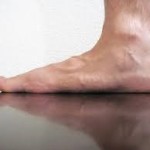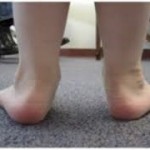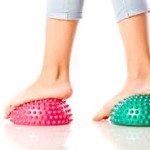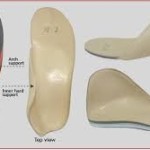Pediatric flatfoot refers to a structural deformity that occurs in children, which involves the lack of a developed arch of the foot. This can further be classified as symptomatic or asymptomatic. In the latter, the child exhibits no symptoms. This condition is sometimes called “pronated foot” by doctors and therapists.
Symptomatic flatfoot in children is characterized by pain or tenderness in the foot or leg. There may be an alteration in the child’s walking patterns, with a valgus heel (rearfoot turned outward) and difficulty wearing shoes. The child may also tire easily, seeming to lack energy to participate in physical activities.
 It is important to note that all children start out with little to no arch when they first start walking. As they mature, the medial midfoot plantar fat pad in the foot starts decreasing, leading to the development of a clearly identifiable medial longitudinal arch.
It is important to note that all children start out with little to no arch when they first start walking. As they mature, the medial midfoot plantar fat pad in the foot starts decreasing, leading to the development of a clearly identifiable medial longitudinal arch.
 In some children, however, the force of certain movements (pathomechanical) acts on the foot to cause a host of compensatory movements which affect the child’s gait function. There is noted fatigue of the lower extremity and the child may constantly want to be carried.
In some children, however, the force of certain movements (pathomechanical) acts on the foot to cause a host of compensatory movements which affect the child’s gait function. There is noted fatigue of the lower extremity and the child may constantly want to be carried.
One possible reason for abnormal functioning of feet in children is a genetic predisposition to develop the condition. Biomechanical factors can contribute to the progression of flatfeet in children, like torsional problems in the transverse plane such as an adduction of the metatarsus (forefoot pointed to medial line – inside) or femoral (thigh) and tibial (shin-low leg) rotation.
Excessive internal hip rotation, rearfoot and forefoot varus (inversion- inward turning), limitations of dorsiflexion, equinus (foot pointed down- ”horse’’ foot) or pseudo torsion (Rotation) at the knee can also lead to acquired deformities of the foot.
A careful musculoskeletal assessment is required to spot anatomical compensations that signal the presence of an abnormal foot position. The foot needs to be evaluated in both weight bearing and non-weight bearing positions. Apart from a thorough gait analysis, the physical examination must include a detailed inspection for tenderness, severity of the deformity, range of motion, muscle strength, and spasticity. Any family history of foot deformities and medical conditions such as neurological disorders also need to be taken into consideration.
 Based on the results of such a foot evaluation, an appropriate treatment modality can be constructed. Orthotics provide early arthrokinematic (joint motion) care to children to prevent latent disability in adulthood. If not looked into at a young age, the loss of posterior tibialis function can trigger the development of a host of foot conditions as the child grows up. By supporting the child’s foot in its optimal position, orthotics ensure that mechanical instabilities are treated at an early stage, while improving posture and balance.
Based on the results of such a foot evaluation, an appropriate treatment modality can be constructed. Orthotics provide early arthrokinematic (joint motion) care to children to prevent latent disability in adulthood. If not looked into at a young age, the loss of posterior tibialis function can trigger the development of a host of foot conditions as the child grows up. By supporting the child’s foot in its optimal position, orthotics ensure that mechanical instabilities are treated at an early stage, while improving posture and balance. This also promotes proper growth and development. Compensatory motions are eliminated and full functionality is restored to the medial arch height while maintaining the optimal structural integrity of the foot. This encourages healthy supination (inversion-inward turn) and functional pronation (eversion-outward turn) of the foot throughout daily activities; orthotics provide for the constant postural adjustments and readjustments the body undertakes on different terrain during the day. There is also less expenditure of energy due to the optimal alignment of the muscles, tendons and ligaments; the child is able to engage in physical activities without the constant feeling of lethargy.
This also promotes proper growth and development. Compensatory motions are eliminated and full functionality is restored to the medial arch height while maintaining the optimal structural integrity of the foot. This encourages healthy supination (inversion-inward turn) and functional pronation (eversion-outward turn) of the foot throughout daily activities; orthotics provide for the constant postural adjustments and readjustments the body undertakes on different terrain during the day. There is also less expenditure of energy due to the optimal alignment of the muscles, tendons and ligaments; the child is able to engage in physical activities without the constant feeling of lethargy.
References:
Russell G. Volpe (2012) Pediatric Flatfoot: When Do You Treat It? Podiatry Today: January 2012, Vol. 25, No. 1.
Michelle L. Butterworth (2010) A Systematic Approach To Pediatric Flatfoot: What to Do and When to Do It. Retrieved from: http://www.podiatryinstitute.com





